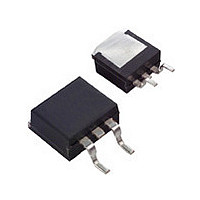MTB33N10E ON Semiconductor, MTB33N10E Datasheet - Page 5

MTB33N10E
Manufacturer Part Number
MTB33N10E
Description
Manufacturer
ON Semiconductor
Type
Power MOSFETr
Datasheet
1.MTB33N10E.pdf
(10 pages)
Specifications of MTB33N10E
Number Of Elements
1
Polarity
N
Channel Mode
Enhancement
Drain-source On-res
0.06Ohm
Drain-source On-volt
100V
Gate-source Voltage (max)
±20V
Continuous Drain Current
33A
Power Dissipation
2.5W
Operating Temp Range
-55C to 150C
Operating Temperature Classification
Military
Mounting
Surface Mount
Pin Count
2 +Tab
Package Type
D2PAK
Dc
0106
Lead Free Status / Rohs Status
Not Compliant
Available stocks
Company
Part Number
Manufacturer
Quantity
Price
Company:
Part Number:
MTB33N10E
Manufacturer:
ON
Quantity:
1 537
the maximum simultaneous drain−to−source voltage and
drain current that a transistor can handle safely when it is
forward biased. Curves are based upon maximum peak
junction temperature and a case temperature (T
Peak repetitive pulsed power limits are determined by using
the thermal response data in conjunction with the procedures
discussed
Resistance−General Data and Its Use.”
traverse any load line provided neither rated peak current
(I
transition time (t
power averaged over a complete switching cycle must not
exceed (T
in switching circuits with unclamped inductive loads. For
DM
The Forward Biased Safe Operating Area curves define
Switching between the off−state and the on−state may
A Power MOSFET designated E−FET can be safely used
14
12
10
8
6
4
2
0
0
) nor rated voltage (V
Figure 8. Gate−To−Source and Drain−To−Source
Q1
J(MAX)
Q3
10
in
Voltage versus Total Charge
r
,t
− T
f
) do not exceed 10 μs. In addition the total
Q
G
C
, TOTAL GATE CHARGE (nC)
20
AN569,
)/(R
QT
θJC
).
Q2
30
DSS
DRAIN−TO−SOURCE DIODE CHARACTERISTICS
) is exceeded and the
33
30
27
24
21
18
15
12
“Transient
9
6
3
0
0.5
Figure 10. Diode Forward Voltage versus Current
40
0.55
V
T
GS
J
= 25°C
= 0 V
V
0.6
I
T
D
SAFE OPERATING AREA
SD
J
C
50
= 33 A
= 25°C
, SOURCE−TO−DRAIN VOLTAGE (VOLTS)
) of 25°C.
V
0.65
Thermal
V
GS
http://onsemi.com
DS
0.7
60
140
120
100
80
60
40
20
0
0.75
5
0.8
reliable operation, the stored energy from circuit inductance
dissipated in the transistor while in avalanche must be less
than the rated limit and adjusted for operating conditions
differing from those specified. Although industry practice is
to rate in terms of energy, avalanche energy capability is not
a constant. The energy rating decreases non−linearly with an
increase of peak current in avalanche and peak junction
temperature.
drain−to−source avalanche at currents up to rated pulsed
current (I
continuous current (I
custom. The energy rating must be derated for temperature
as shown in the accompanying graph (Figure 12). Maximum
energy at currents below rated continuous I
assumed to equal the values indicated.
1000
100
Although many E−FETs can withstand the stress of
10
0.85
1
V
I
V
T
D
DD
GS
J
0.9
= 33 A
= 25°C
DM
= 50 V
= 10 V
Figure 9. Resistive Switching Time
Variation versus Gate Resistance
0.95
), the energy rating is specified at rated
t
d(off)
t
d(on)
1.0
R
t
G
t
f
r
, GATE RESISTANCE (OHMS)
1.05
D
), in accordance with industry
10
D
can safely be
100










